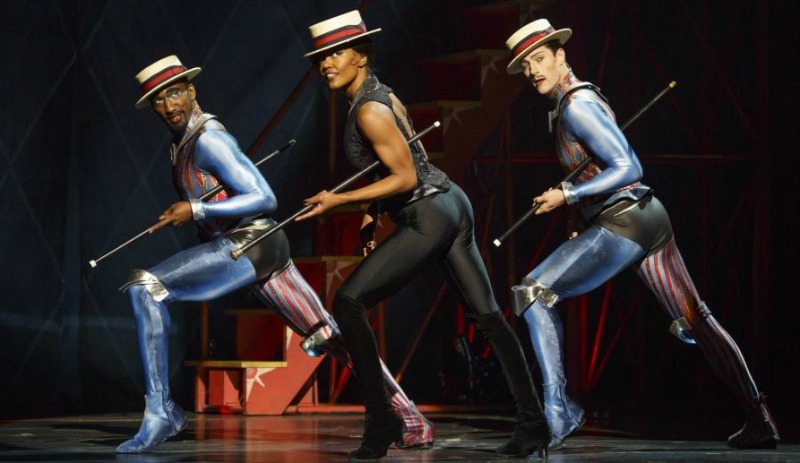Countdown to PIPPIN with The 'Pippin' Profiles: Bob Fosse protégé Chet Walker
Posted on July 4th, 2015
The ‘Pippin’ Profiles: Bob Fosse protégé Chet Walker
by John Moore | Aug 14, 2014

Choreographer Chet Walker believes the legendary Bob Fosse “had a style, not a technique.”
Bob Fosse has been gone for 27 years, but protégé Chet Walker still refers to the icon of modern dance exclusively as “Mr. Fosse.”
“He deserves that respect,” Walker said.
When Walker met Fosse in 1972, “I was the size of a peanut,” he said. Walker was 16 and auditioning to join the cast of Fosse’s TV concert, Liza with a Z. Two years later, he was added to the company of Pippin, playing a peasant. That led to several impressionable years “behind the table” assisting and observing Fosse, who died in 1987. Walker then conceived the Broadway tribute Fosse, which won the 1989 Tony Award for best musical.
Walker doesn’t know the driven, oversexed hothead many people remember as the semi-fictional character Roy Scheider played in the Fosse-directed film, All that Jazz. The mentor Walker knew never raised his voice or got angry. He says the primary lessons Fosse taught him were “humanity, how to be with people and how to listen.”
Wait … not technique?
‘That’s the thing: Mr. Fosse didn’t have a technique,” said Walker. “What he did have was incredible style.”

When Pippin Director Diane Paulus knew she wanted to bring Pippin back to life and set it in the athletic and sensuous world of circus acrobatics and gymnastics — “we knew we had to bring back the Fosse, too,” she said. “It’s just too connected.”
Paulus also knew there was only one man for the job of “bringing back the Fosse”: Choreographer Chet Walker.
“He had worked with Fosse for years, and so having Chet was so important to me,” she said.
When Paulus told Walker she wanted to transplant Stephen Schwartz and Roger O. Hinson’s quintessential musical search for meaning inside the world of the circus, she got all the confirmation she needed that she was on the right path from Walker. “He told us about Fosse’s fascination with all things (Federico) Fellini and clowns,” Paulus said. “And really that’s all over even the original choreography. It’s almost inside the DNA of the original production.”
When they got into the rehearsal room, Pippin Circus Creator Gypsy Snyder says Walker “was the holder of all things Fosse.” But the goal was not – except in certain circumstances, to merely re-create Fosse’s signature choreography. It was to tell the story “in the style of Mr. Fosse,” Walker said.
In a wide-ranging interview, Walker talks about being “the keeper of the Fosse flame,” and what exactly “the style of Mr. Fosse” really means. And take our word for it – it ain’t “jazz hands” ….
John Moore: What goes through your mind when you’re told, ‘You are the only person for this job’?
Chet Walker: It’s interesting because I didn’t know exactly what ‘my job’ was going to be in the beginning, or how it was all going to work. You had what Gypsy was doing with the circus, and then you had Diane’s vision, and then there was this question of how to incorporate Mr. Fosse’s work — or the work that would be in his style. We knew we should not just try to repeat Mr. Fosse’s work, because the concept of this show is very different. So … it was daunting, I can tell you that. To be honest, I didn’t really know how to do it at first. But Diane is such an amazing director, and she was very clear as to the possibilities. So we literally looked at all the possibilities of how the circus and dance and acting could all work together, and I think we ultimately got it to be very seamless. But I don’t think we knew exactly how to do that in the beginning.
John Moore: That had to be the fun of it though, wasn’t it — the not knowing?
Chet Walker: Oh, yes. But you have to understand that back in the 1970s, we didn’t question anything. We did what Mr. Fosse said to do. He was a Svengali in a very positive way. You see, I wasn’t in the original Pippin cast. I came in when everyone went to Chicago, about two years after it first opened. Back then, our entire version of Pippin was based on Mr. Fosse’s vision of that show. When you look at this new version of the show, very little has changed in the script, and nothing at all has changed in the music. And yet nevertheless … it’s a whole different show. It’s amazing that after 40 years the same story can be told in a whole different arena. It’s not really a revival, per se … I believe it is truly a new show.
John Moore: What were your first impressions of meeting Mr. Fosse?
Chet Walker: Oh my gosh, I was a mere child. I went to the audition for Liza with a Z. I had my tights on, my white little socks, my ballet shoes and a black and green and white striped shirt. I was the size of a peanut. It was a Saturday, and it was raining, and I really don’t know why I even showed up. But I did. I was this embryonic little person surrounded by all of these men. But the way that Mr. Fosse responded to me was not like he responded to anybody else. He allowed me to stay. He was kind, and so generous. The whole time, my eyes were just … open. I had not been around a male figure like that before. A lot of my dancing teachers were female, so I had never really been around a dominating male figure who was that charismatic. I mean, let’s face it: The guy was charismatic.

John Moore: What did you learn from him?
Chet Walker: His teaching wasn’t like teaching. It was like observation. It was like being in a lab and being able to observe everything from many different points of view. A lot of the people who were around him were muses, or people he was creating things for. I was really a different person in the room. Yes, I was a performer for him, but my relationship was always behind the table, talking about why, when, how this and that. And that made my relationship with him so different. So when people talk about him the way they do, I don’t recognize this person that they talk about.
John Moore: After spending so many years over his shoulder, what was it like when it was your time to step forward?
Chet Walker: Well, his passing made that happen. When he passed away while we were doing Sweet Charity, I figured I would just be a dancer for as long as I could dance, and that would be it. On his passing, yes, mine was one of the shoulders it was put on. I would go out and do all kinds of things that were related to Mr. Fosse. But I had created what we now know as (the musical) Fosse long before it was called Fosse. It started with a TV show that I brought to him back in 1985. And it took me 15 years to finally get it to where it was a Broadway show. That was a huge responsibility — but it was one that I wanted to have. When you want to have a responsibility, it’s not such a hardship. And boy, you think you know someone … until you start to really do the work. I remember on my first meeting with him about the show, I brought all my research to him. And he looks at it and says, ‘Well you know, this is not everything I’ve done.’ And I’m like, ‘Oh no?’ He would always have that smirk because he would tell you things and you would say, ‘Oh my God, you’re kidding me — You did that, too?’ It was interesting. The whole process of knowing this man and knowing his work and watching how he worked in the business … you can’t go to school for that.
John Moore: I mean this next question in all sincerity, although it’s going to sound provocative. But I think you have made quite a legacy for yourself when a man from the dance world, which is not widely known by the general public, is identifiable by the mere saying of the words … ‘Jazz hands.’ Everyone knows you are talking about Bob Fosse.
Chet Walker: Well I never equate that to Mr. Fosse, because ‘jazz hands’ is a position. And in Mr. Fosse’s world, those hands in a dance would have ended up being some sort of imagery. It’s funny because people go, ‘I’m a Fosse dancer,’ and I always go, ‘Well, that’s interesting, because if you didn’t actually work with Mr. Fosse, then you are not a Fosse dancer. It’s sort of like, ‘You’re not a Balanchine dancer unless you have worked with Mr. Balanchine. Now, you may have learned from other Balanchine dancers, which is just phenomenal, but … it’s not the same thing. Mr. Fosse would never have called what he did ‘Fosse.’ Do you know what I mean? He would never have said, ‘OK everyone, today, we are going to do Fosse.’ What he did was all imagery. It’s weird because people like to say, ‘Oh, I am going to teach the technique of Bob Fosse,’ and I say, ‘But he didn’t have a technique.’ He had an incredible style. I don’t believe that there is any one person other than Jack Cole who had a specific, ‘Wow pow, oh my gosh’ moment like Mr. Fosse. Now, Jack Cole had both a technique, and a style. But Mr. Fosse didn’t have a technique per se. He had a style that was amazing.

John Moore: And how would you describe that style?
Chet Walker: Well, it’s unlike anyone else’s. Other choreographers use many kinds of styles. And many of those styles were unbelievable. But Mr. Fosse’s? When you see that walk, or you see those arms — it is just kind of breathtaking. It really is, because it’s not something that you see all the time. There is such acting in it. There is such imagery in it. It’s not just dance movement. There is drama, there is humor, there is entertainment. If you look at any musical that Mr. Fosse ever had his hand in, there was always something that I call ‘the underbelly.’ There’s always an underneath side of what’s going on. He totally could entertain you, but if you look beyond the entertainment aspect of it, he’s probably saying something else. And in Pippin — most definitely. When Mr. Schwartz wrote this with Roger O. Hinson in the 1970s, there were a lot of things going on that pertained to the piece — Charles Manson, the war, what our government was doing. Things were not always as they appeared. Mr. Fosse was very much an advocate of making it show business, and making it so that you can see the show of it. So we have a whole war section in Pippin. And then there’s this whole business of The Manson Trio. That’s an iconic piece of vaudeville as we are tap-dancing through the war. And if you relate that back to Vietnam or any other war that this country has ever gone through, there’s a lot that seems to be a cover-up. There is a lot of not wanting to actually see it for what it is. There is a lot of show business to it. Mr. Fosse was such a patriotic man.

Anthony Wayne, Patina Miller and Andrew Fitch perform Bob Fosse’s iconic “The Manson Trio” in the 2013 Broadway revival of “Pippin.” Photo by Joan Marcus.
John Moore: You have said Mr. Fosse called the signature Manson Trio dance that because the Leading Player is a bit of a charismatic cult leader, as was Charles Manson. That he liked the juxtaposition of song-and-dance with people being killed. So will we see The Manson Trio in the new Pippin?
Chet Walker: Absolutely. The Manson Trio is all his. That’s Mr. Fosse’s. That’s not mine. There would be no way I could have ever created anything more perfect than that.
John Moore: When you see any Fosse show today, you still know instantly who originally choreographed it. Can you talk about how Mr. Fosse lives on in what you’ve done?
Chet Walker: Well, thanks that you think that. I think when you look at what we have created in Pippin, you will see a sense of showmanship to the circus, and to the theatrical. Hopefully I have paid homage to him well, and that you probably have never seen anything quite like it before.
John Moore: We’ve all seen wonderful Broadway shows that play well in front of 1,000 people, and then they go out on the road and get swallowed up in these large, 3,000-seat roadhouses. But here the dancing and the circus element and the aerials actually allow Pippin the unique opportunity to actually grow into the space and take advantage of the larger canvas.
Chet Walker: This show can be played to a huge audience or to a small audience, and I think it works for both. There’s going to be an intimacy to it no matter what, because the story is intimate. But the story is also huge. It is small, but it’s also so impactful. And then when you see all that we have happening on that stage, I think that’s what makes it so powerful.”
John Moore: Considering the gymnastics and high-flying and the muscular nature of this new Pippin, do you think if these performance techniques were available in the 1970s, Mr. Fosse would have done this same thing himself?
Chet Walker: Oh, I think so. He absolutely loved clowns, and he collected all kinds of things about clowns. You never can really know what people would have thought, but if someone had come up with the idea of doing this in 1972, I think Mr. Fosse would have jumped on the bandwagon. He would have gone for the challenge and wanted to see what that was all about. Totally.
John Moore was named one of the 12 most influential theater critics in the U.S by American Theatre Magazine in 2011. He has since taken a groundbreaking position as the Denver Center’s Senior Arts Journalist.
Note: “The Pippin Profiles” is a series of interviews by Arts Journalist John Moore with the “Pippin The Musical” cast and creative team leading up to the launch of the first national touring production in Denver on Sept. 6. Dallas Summer Musicals is re-posting these on the DSM Blog to countdown the Opening Night of PIPPIN at the Music Hall at Fair Park – July 7-19!
PIPPIN is presented by Dallas Summer Musicals July 7-19 at Music Hall at Fair Park. TICKETS ON SALE NOW! Just go to http://tinyurl.com/og2sxh7. For more details, click here.
Want a chance to win tickets to opening night? Download our mobile app and take our quick trivia quiz! To download our app, Apple users click here and Android users click here!




